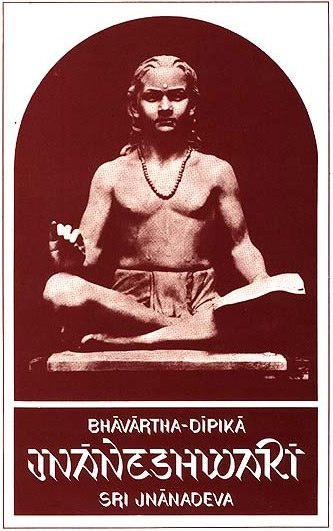Jnaneshwari (Bhavartha Dipika)
by Ramchandra Keshav Bhagwat | 1954 | 284,137 words | ISBN-10: 8185208123 | ISBN-13: 9788185208121
This is verse 18.41 of the Jnaneshwari (Bhavartha-Dipika), the English translation of 13th-century Marathi commentary on the Bhagavad-Gita.—The Dnyaneshwari (Jnaneshwari) brings to light the deeper meaning of the Gita which represents the essence of the Vedic Religion. This is verse 41 of the chapter called Moksha-sannyasa-yoga.
Verse 18.41
Verse 18.41: “Of the Brahmins (Priests), Kshattriyas [Kshatriyas] (Warriors), and the Vaishyas (Producers and Merchants), and also of the Shudras (Menials), Oh Tormentor of the enemy, the (respective) functions are differentiated according to the Guna-constituents which fashion their innate natures. (818)
Commentary called Jnaneshwari by Jnaneshwar:
If you ask me which are the four castes, they are those, the chief amongst whom are the Brahmins (Priests) in the forefront. Others are the Kshatriyas (Warriors) and Vaishyas (Producers and Merchants), who are also as high in position as the Brahmins, being qualified to perform rituals as laid down in the Vedas. The fourth, Oh Dhananjaya, are the Shudras (Menials) who are not qualified (to act) according to the Vedas and have therefore got to be dependent on the three others for their living. But because the living of the Shudras is linked with the three other castes, they have been included in the caste system and are made the fourth caste.
The Shruti Scripture has owned the Shudras along with the twice-born (dvija) in the way, the rich ones, while inhaling the fragrance of flowers (of a garland etc.) also smell the thread on which they (flowers) are inwoven. Such is, Oh Partha, the arrangement of the fourfold caste system. I now tell you their respective functions, by performing which, all these four castes escape the pair of scissors in the form of birth and death, and attain Supreme Self.
The three Guna-constituents, Sattva and others, born of my Prakriti have distributed in four lots the functions amongst the four castes. The father divides his self-acquired property amongst his sons; or the Sun shows the different ways to different wayfarers; or the master assigns several duties to his servants; in that way the Guna-constituents born of the Prakriti have made the distribution of the duties among the four.
The Sattva quality has put under its supremacy the Brahmins and the Kahatriyas and has divided itself in two equal halves assigning one to each of the two. The Vaishyas have been assigned to Sattva and Rajas combined together, while the Shudras (have been assigned to) Rajas and Tamas combined together. In this way, know it, that the three Guna-constituents, divided into four distinct castes the entire human order constituting one single group. The Scriptures show in detail the different functions covered by the three Gunas, in the way objects kept in the dark are found in lamp light. Now I proceed to explain the respective proper qualities (functions) of those castes and you the fortunate one (lit. the storehouse of good luck) do hear them.
